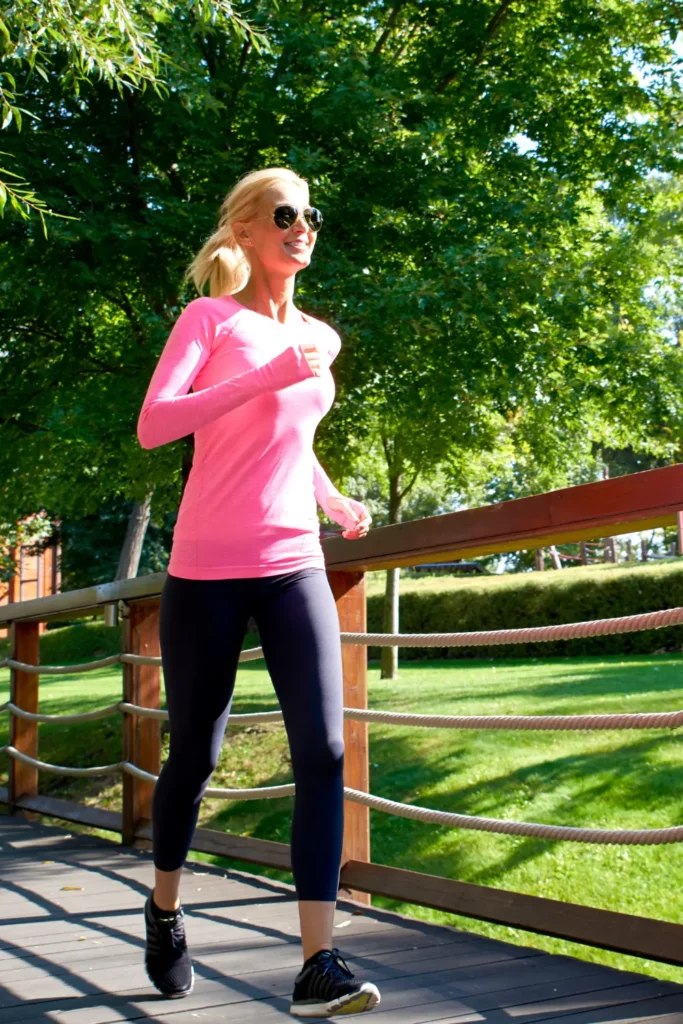Beat the post-Christmas blues with this beginner running challenge.
This challenge is designed for beginners who are new to running or looking to kickstart their fitness journey in the new year.
It’s also great for anyone returning to running after a break.
Various studies have proven the benefits of running for your physical and mental health – so what better way to start the new year than with a running challenge.
The challenge gradually builds endurance, stamina over a four-week period, and also incorporates rest days for optimal recovery.
Ready?
Let’s go!

28-day beginner running challenge
Before completing this challenge, it’s important you consult with a healthcare professional, especially if you’re returning to running following an injury or after childbirth, for example.
The aim of the challenge is to get you up and running after the festive season.
If any of the running/walking intervals are too long, you can adapt these to suit your fitness levels. Just make sure you add in the appropriate amount of walking breaks.
Your pace during each run should feel comfortable. This means that you should be able to comfortable hold a conversation without getting out of breath.
The challenge includes the following types of workouts and rest days:
- Running and walking intervals
- Active rest days (e.g. days where you only do low impact or gentle exercise)
- Rest days (e.g. complete rest days to allow your body to recover)
- Optional strength training workouts.
Week 1: Establish a routine
Day 1 – Monday:
- Warm up with a light jog and some dynamic stretching.
- Run/walk for 18 minutes: Run at a comfortable pace for 1 minute, followed by 2 minutes of brisk walking. Repeat 6 times.
- Cool down with some light stretching.
Day 2 – Tuesday:
- Active rest: Engage in a low-impact activity such as cycling or swimming for 30 minutes.
- Optional: Core strengthening exercises.
Day 3 – Wednesday:
- Warm up with a light jog and some dynamic stretching.
- Run/walk for 24 minutes: Run at a comfortable pace for 2 minutes, followed by 2 minutes of brisk walking. Repeat 6 times.
- Cool down with some light stretching.
Day 4 – Thursday:
- Rest day: Focus on recovery with gentle stretching or yoga.
Day 5 – Friday:
- Warm up with a light jog and some dynamic stretching.
- Run/walk for 30 minutes: Run at a comfortable pace for 3 minutes, followed by 2 minutes of brisk walking. Repeat 6 times.
- Cool down with some light stretching.
Day 6 – Saturday:
- Active rest: 30 minutes of low-impact activity such as walking, cycling or swimming.
- Optional: Bodyweight exercises focusing on legs and core.
Day 7 – Sunday:
- Rest day: Allow your body to recover fully. Drink plenty of water.
Related: Mastering mile one: 10 tips to conquer the first mile of a run

Week 2: Build endurance
Day 8 – Monday:
- Warm up with a light jog and some dynamic stretching.
- Run/walk for 30 minutes: Run at a comfortable pace for 4 minutes, followed by 2 minutes of brisk walking. Repeat 5 times.
- Cool down with some light stretching.
Day 9 – Tuesday:
- Active rest: 30 minutes of low-impact activity such as walking, cycling or swimming.
- Stretching routine focusing on legs.
Day 10 – Wednesday:
- Warm up with a light jog and some dynamic stretching.
- Run/walk for 35 minutes: Run at a comfortable pace for 5 minutes, followed by 2 minutes of brisk walking. Repeat 5 times.
- Cool down with some light stretching.
Day 11 – Thursday:
- Rest day: Prioritise rest, consider gentle yoga or Pilates.
Day 12 – Friday:
- Warm up with a light jog and some dynamic stretching.
- Run/walk for 40 minutes: Run at a comfortable pace for 6 minutes, followed by 2 minutes of brisk walking. Repeat 5 times.
- Cool down with some light stretching.
Day 13 – Saturday:
- Active rest: 30 minutes of low-impact activity such as walking, cycling or swimming.
- Optional: Full body workouts.
Day 14 – Sunday:
- Rest day: Allow your body to recover fully. Drink plenty of water.
Related: The magic of the easy run: Why they are crucial for stronger and happier running

Week 3: Increase intensity
- Gradually increase the duration of your runs, aiming for 50-55 minutes by the end of the week.
- Include a mix of continuous running and walking as needed.
Day 15 – Monday:
- Warm up with a light jog and some dynamic stretching.
- Run/walk for 45 minutes: Run at a comfortable pace for 7 minutes, followed by 2 minutes of brisk walking. Repeat 5 times.
- Cool down with some light stretching.
Day 16 – Tuesday:
- Active rest: 30 minutes of low-impact activity such as walking, cycling or swimming.
- Stretching routine focusing on legs.
Day 17 – Wednesday:
- Warm up with a light jog and some dynamic stretching.
- Run/walk for 55 minutes: Run at a comfortable pace for 8 minutes, followed by 3 minutes of brisk walking. Repeat 5 times.
- Cool down with some light stretching.
Day 18 – Thursday:
- Rest day: Prioritise rest, consider gentle yoga or Pilates.
Day 19 – Friday:
- Warm up with a light jog and some dynamic stretching.
- Run/walk for 55 minutes: Run at a comfortable pace for 8 minutes, followed by 3 minutes of brisk walking. Repeat 5 times.
- Cool down with some light stretching.
Day 20 – Saturday:
- Active rest: 30 minutes of low-impact activity such as walking, cycling or swimming.
- Optional: Full body workouts.
Day 21 – Sunday:
- Rest day: Allow your body to recover fully. Drink plenty of water.
Related: The ultimate 30 day workout challenge for runners

Week 4: Final push and celebration
Day 22 – Monday:
- Warm up with a light jog and some dynamic stretching.
- Run/walk for 60 minutes: Run at a comfortable pace for 8 minutes, followed by 2 minutes of brisk walking. Repeat 6 times.
- Cool down with some light stretching.
Day 23 – Tuesday:
- Active rest: 30 minutes of low-impact activity such as walking, cycling or swimming.
- Stretching routine focusing on legs.
Day 24 – Wednesday:
- Warm up with a light jog and some dynamic stretching.
- Run/walk for 60 minutes: Run at a comfortable pace for 9 minutes, followed by 1 minutes of brisk walking. Repeat 6 times.
- Cool down with some light stretching.
Day 25 – Thursday:
- Rest day: Prioritise rest, consider gentle yoga or Pilates.
Day 26 – Friday:
- Warm up with a light jog and some dynamic stretching.
- Run/walk for 60 minutes: Run at a comfortable pace for 9 minutes, followed by 1 minutes of brisk walking. Repeat 6 times.
- Cool down with some light stretching.
Day 27 – Saturday:
- Active rest: 30 minutes of low-impact activity such as walking, cycling or swimming.
- Optional: Full body workouts.
Day 28 – Sunday:
- Rest day: Allow your body to recover fully. Drink plenty of water.
Related: The ultimate 30 day strength training plan for runners

What to do after completing the challenge
Congrats! You have finished the 28-day beginner running challenge!
Now is a good time to reflect on achievements and set future running goals.
Whether you want to run a 5k, 10k or you even have your sights on a half marathon – the running world is your oyster!
With the right mindset and motivation you will be able to achieve your running goals.
Related: Hormones and female athletic performance: Everything you need to know
Tips on completing the challenge
- Listen to your body: If at any point you feel pain beyond normal fatigue, consider extra rest in the form of additional rest days.
- Stay hydrated and fuel your body with a nutritious, balanced diet. Your main source of energy should be carbohydrates before a run and protein after a run.
- Invest in proper running shoes to reduce the risk of injury.
- Warm up before each run with a light jog and dynamic stretches and cool down afterward with gentle stretches.
- Pay attention to your breathing – it should be controlled and steady. If at any point you feel out of breath during a run, it means you are running too fast.
- Enjoy the process and celebrate small victories along the way! Consider documenting your journey so you can look back on the progress you have made.
Related: Fuelling your run: A female runner’s guide to nutrition and running performance
- 5 things I wish I’d known before returning to running - March 3, 2024
- Running 20 minutes a day: Benefits + how to start - January 27, 2024
- How to run your first 2 hour half marathon - January 16, 2024
